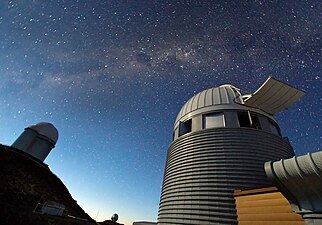Swiss 1.2-metre Leonhard Euler Telescope
 The enclosure of the Leonhard Euler Telescope with the higher situated New Technology Telescope in the background | |
| Alternative names | Swiss 1.2-m Leonhard Euler Telescope |
|---|---|
| Named after | Leonhard Euler |
| Part of | La Silla Observatory |
| Location(s) | Norte Chico |
| Coordinates | 29°15′34″S 70°43′59″W / 29.2594°S 70.7331°W |
| Organization | Geneva Observatory |
| First light | 12 April 1998 |
| Telescope style | reflecting telescope |
| Diameter | 1.2 m (3 ft 11 in) |
| | |
Leonhard Euler Telescope, or the Swiss EULER Telescope, is a national, fully automatic 1.2-metre (47 in)
The Euler telescope uses the CORALIE instrument to search for
exoplanets. In addition, the telescope uses the multi-purpose EulerCam (ecam), a high precision photometry instrument, and a smaller, piggyback mounted telescope, called "Pisco".[2] Its first discovery was a planet in orbit around Gliese 86, determined to be a hot Jupiter with an orbital period of only 15.8 earth days and about four times the mass of Jupiter.[3]
Since then, many other exoplanets have been discovered or examined in follow-up observations.
Together with the
SuperWASP.[5]
Instruments
The CORALIE spectrograph is an
spectrograph used for astronomy. It is a copy of the ELODIE spectrograph used by Michel Mayor and Didier Queloz to detect the planet orbiting a star . In April 1998 it was built and installed at the Euler Telescope. Later in 2007 it was upgraded by Didier Queloz and his team to increase its performances to support Wide Angle Search for Planets program and Next-Generation Transit Survey. The instrument is optimized to measure Doppler effect on a star's electromagnetic spectrum with great precision to detect the gravitational tug of an exoplanet orbiting around it.[6][7] It also known as "radial velocity" or "wobble" method, is an indirect detection method
. The mass of the planet can be estimated from these measurements.
The spectrograph participates in the Southern Sky extrasolar Planet search Programme initiated by Michel Mayor
In 2010 visible camera EulerCam was installed by
transit method by supporting ground base program such as Wide Angle Search for Planets
. The size of an exoplanet can be estimated using the transit method. By combining the measured size and mass from both methods, it can be determined whether the observed exoplanet is gaseous or rocky.
Characteristics
The resolution of CORALIE is fixed at R = 50,000 with a 3 pixel sampling. The detector CCD is 2k X 2k with a 15 micrometer pixel size.
Discovered exoplanets
First five planetary object discovered using CORALIE are
| Planet | Announced in | Refs |
|---|---|---|
| Gliese 86 b | 1998 | [6] |
| HD 75289 b | 1999 | [8] |
Eiger |
1999 | [8] |
Beirut |
1999 | [9][10] |
| GJ 3021 b | 2000 | [11] |
Gallery
-
The 1.2-meter Leonhard Euler Telescope
-
Euler Telescope with the ESO 3.6-meter in the background
-
A fisheye view of the Euler Telescope
-
Euler and ESO 3.6-meter are both exoplanet hunters at La Silla
-
Moonlight and Zodiacal Light Over La Silla Observatory
-
Sunset at ESO's La Silla observatory in Chile
-
Fantastic Mr Fox
Video
See also
References
- ^ "Swiss 1.2-metre Leonhard Euler Telescope". ESO. Retrieved 10 September 2015.
- ^ a b "EULER". Exoplanets. Switzerland: Université de Genève. Retrieved 10 September 2015.
- ^
Queloz, D.; Mayor, M.; Weber, L.; Blecha, A.; et al. (1999). "A planet orbiting the star Gliese 86". arXiv:astro-ph/9910223.
- ^ "Southern Sky extrasolar Planet search Programme". unige.ch.
- S2CID 35774603.
- ^ Bibcode:2000A&A...354...99Q.
- ^ ESO publication, D. Queloz and M. Mayor, From CORALIE to HARPS, September 2001
- ^ a b
Udry; Mayor, M.; Naef, D.; Pepe, F.; et al. (2000). "The CORALIE survey for southern extra-solar planets II. The short-period planetary companions to HD 75289 and HD 130322". Bibcode:2000A&A...356..590U.
- ^
Santos, N.; Udry, S.; Mayor, M.; Naef, D.; et al. (2003). "The CORALIE survey for southern extra-solar planets XI. The return of the giant planet orbiting HD192263". S2CID 16247618.
- ^
Santos, N.; Mayor, M.; Naef, D.; Pepe, F.; et al. (2000). "The CORALIE survey for southern extra-solar planets III. A giant planet in orbit around HD 192263". Bibcode:2000A&A...356..599S.
- ^
Naef, D.; Mayor, M.; Pepe, F.; Queloz, D.; et al. (2001). "The CORALIE survey for southern extrasolar planets V: 3 new extrasolar planets". S2CID 16606841.
External links
Wikimedia Commons has media related to Leonhard Euler Telescope.












